Ensuring the safety of your tented event is paramount, especially when hosting gatherings in Indianapolis and throughout Indiana. Adhering to local regulations, implementing best practices, and understanding the nuances of tent safety can make the difference between a successful event and a potential hazard. Building upon the foundational guidelines, here are additional insights and recommendations to enhance the safety of your tented events.
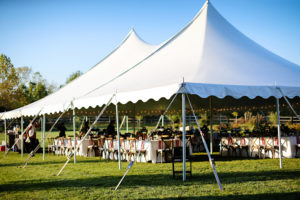
Understanding Local Regulations and Permits
In Indiana, specific regulations govern the use of temporary structures like tents. For instance, the City of Indianapolis mandates that any temporary structure over 3,200 square feet requires a permit, while structures exceeding 400 square feet necessitate a notification to the city authorities. Other municipalities, such as Carmel and Lawrence, have their own stipulations. Carmel requires a permit for any temporary structure on commercial property, and Lawrence mandates permits for all temporary structures, regardless of location. It’s crucial to consult with local authorities to ensure compliance with all applicable codes and regulations. As a courtesy, A Classic Party Rental will handle the permit process and submit the necessary notifications on your behalf. For permits, we must provide a layout, a detailed tent diagram, a Certificate of Flame Resistance, and complete the required forms—either online or by hand delivery, depending on the city’s regulations.
Note: Permits are also required for stages taller than 30 inches. To simplify the process, we typically recommend a maximum stage height of 24 inches unless specific circumstances require otherwise. In such cases, the renter will be responsible for obtaining the necessary staging permits.
Who knew tenting could be so complex? Thankfully, A Classic Party Rental has dedicated Tent Specialists ready to make the process seamless. With our expertise, you can focus on the fun aspects of event planning while we handle the permits, notifications, site preparation, and logistics—leaving you stress-free and ready to celebrate!
Photography: Chloe Luka Photography
Anchoring: Staking vs. Weighting
Proper anchoring is essential to maintain the stability of your tent. Staking is the preferred method, involving driving stakes at least 3 feet into the ground to secure the tent. This method is effective but requires awareness of underground utilities, necessitating coordination with services like Indiana811 to prevent accidental disruptions. In situations where staking isn’t feasible, such as on hard surfaces, weighting becomes necessary. The City of Indianapolis requires 18 pounds per square foot for anchoring tents using concrete ballasts. Water barrels are discouraged due to their insufficient holding power. For recurring events on commercial properties, drop-in concrete anchors can be a viable solution, provided the concrete is intact and at least 6 inches deep.
Staked Tent:
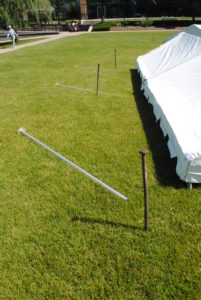
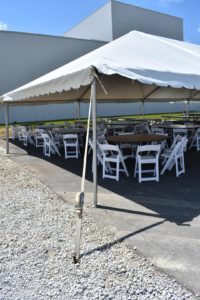

Weighted Tent:
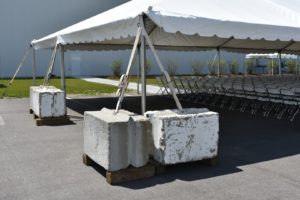
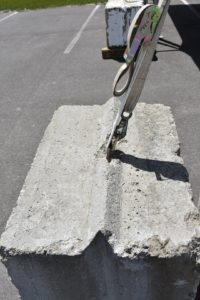
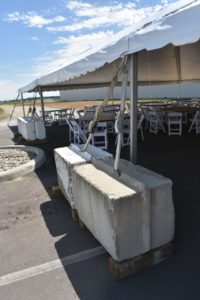
Fire Safety Measures
Fire safety is a critical aspect of tented events. Indiana State Law, under Chapter 31 of the Indiana State Code, requires a Fire Code Package for tents over 400 square feet. This package includes fire extinguishers, “No Smoking” signs, and exit signs. The quantity and placement of these items depend on the tent’s size. Ensuring that all materials used in the tent are flame-resistant is also mandatory. Regular inspections and maintenance of fire safety equipment are essential to uphold safety standards.
Weather Preparedness
Tents are temporary structures and can be vulnerable to extreme weather conditions. It’s imperative to monitor weather forecasts leading up to and during the event. In the event of high winds, heavy rain, or lightning, having a contingency plan is vital. This may include evacuating the tent and relocating guests to a safer, permanent structure. Additionally, ensuring that the tent is equipped with sidewalls can provide extra protection against sudden weather changes.

Lighting and Electrical Safety
Proper lighting is crucial, especially for events extending into the evening. All electrical installations should be performed by qualified professionals to prevent malfunctions that could lead to fires. Cables and wires should be securely fastened and kept out of high-traffic areas to prevent tripping hazards. While candles can enhance ambiance, they pose significant fire risks and should be used with caution or replaced with safer alternatives like LED lights.
Emergency Planning and Exits
Preparation for emergencies is a cornerstone of event safety. Tents should have clearly marked exits, with pathways free from obstructions. The number of exits required depends on the tent’s size and occupancy. It’s advisable to have an emergency response plan in place, including communication strategies and designated assembly points. Staff should be trained to assist guests in case of an emergency, ensuring a swift and orderly evacuation if necessary.

Site Selection and Preparation
Choosing the right location for your tent is foundational to event safety. The site should be level, elevated, and free from debris. Adequate space around the perimeter is necessary for anchoring and emergency access. Before installation, it’s essential to identify and avoid underground utilities to prevent hazards. Coordination with local utility services can provide maps or markings to guide safe installation. Overhead obstructions, such as power lines, should also be considered to prevent potential dangers.
Safety First: Call Before You Dig!
You might be surprised by the number of details needed for tent setup, but safety is our priority. Because our tent stakes penetrate 3 feet into the ground, we’re required by law to notify Indiana811 (https://indiana811.org/) to mark underground utility lines. This prevents accidental damage during installation.
Indiana811 needs at least 48 hours to complete their work, and sometimes longer. To ensure everything is ready for your event, we request the utility locate be completed 5 days beforehand.
To initiate the locate, we’ll need the following information:
- Jobsite name and contact details
- City, County, and Township
- Subdivision (if applicable)
- Lot number (if available)
- Full address
- Nearest intersecting streets (within a half-mile)
- Specific dig location (using compass directions)
- Surface type
- Whether the area will be “white lined”
Understanding Utility Markings: Once the utilities are marked, we’ll carefully avoid those areas during staking. In some cases, we’ll use “white lining” to clearly indicate the proposed dig area to the utility locators.

Ready to start planning your event? Fill out our tent request form or call us at 317.251.7368 to speak with a rental expert today!






